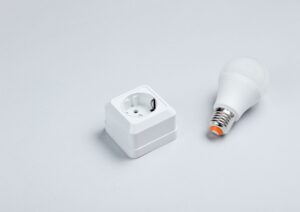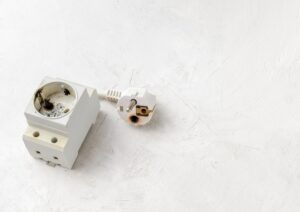The Humble Socket Redesigned
One can miss the simple light socket. Turn a switch, turn on a light, nothing new, is it? However, in real life the switch to energy saving lights is not all about what is blinging. The quiet lingo in the post-modern house? The powerful led bulb socket. As LEDs come into the spotlight and incandescent bulbs are phased out, the redesigning of those contact points is redesigning what we want to expect of brighter, safer, and smarter homes.

Why Old Sockets Cannot Fit in the Contemporary World
But at one point, the lighting climate has been basic: bulbous filaments, hot bulbs, offending ceramic sockets. All the levers operated (or more to the point, all the gears flipped) until something wilted or buzzed. LEDs, however, turned that game around. All of a sudden, the conditions of low heat, sensitive electronics, quick on-and-off cycling, as well as a desire to have rock-steady connections, have also become the new standard.
Big, old sockets-E27 and B22, and their ancient metal brothers-were never made with microchip circuit systems in mind; they were made to take brute-force wattages. Have you ever seen an LED lamp that blinks? Sags? Does not work, randomly? In nine cases out of ten what does not fit is the legacy sockets, not the bulb.
It has another peculiarity: most of the old sockets can loosen with little shaking. The LEDs also don the cool, and therefore what makes them fit in closely is not the same as would be the case with the piping hot halogen or incandescent. The dependability drops between the cracks and with expensive bulbs, that is not a laughing matter.
Tech-Growing Engineering
The sockets that are compatible with LED are not universal. Large companies are launching sockets that take into consideration the fact that LEDs are lighter, smaller, and much more electronic. Now some of these contacts are spring loaded and captures the bulbs of lower wattage securely and does not over tighten them. The others abandon brass to more exotic alloys that combat corrosion and arc burns–issues that wear out old-school sockets in a hurry.
Then comes the issue of fluctuation of voltages. Led are more obsessive than their predecessors. Upgraded sockets now have some form of surge-protective material or integrated voltage stabilisation. No pre discarding of your fancy long-life bulbs on a primary visit to the recycle bin anymore.
Here is the clincher to the home renovator: new sockets tend to be flexible across wide voltage bands (100V to 265V), and thus forward-looking in the cities whose grids are troublesome.
Smarter, Not Safer
Smart home is a fancy term but it all cannot go on without a solid base. Sockets that are LED-ready are being released with built-in chips to connect them (that is, Wi-Fi or Zigbee modules, or at least room to attach them). This implies that a light switch can take smart bulbs, movement-controlled, or even a timed on/off rotation at the very start.
You can observe the problem if you plugged some old lamp and the new smart bulb. The socket occasionally kills power in very odd fashion and breaks network pairing, to bring many a headache. LED sockets now are so regulated that they maintain a small constant trickle-just enough current to power-up low-wattage sensors and microchips to check which commands to execute.

And do not turn a blind eye on upgrade. Replacing an exhausted lamp and future-proofing your lighting system means that the entire house will be on a nicer playing field with automation context, e.g. Alexa voice control, daylight targets, mood lighting during movie watching.
Safety Has a Face Lift
Power has no level of safety. In legacy sockets, insulation against rogue fingers is normally not considered during installation or repair. LED-focused sockets? Smaller spacings, lower resistance to earth (on the case of Earthed-models) and in many cases, deeper shrouds on the inside to prevent prying children with their dangerous fingers.
A few sockets come with tiny fuse holders in them now: invaluable if you happen to be in a place that is prone to power surges or lightning. Others have inbuilt heat sensors which overload before matters turn sour especially in the light-weight-housing-plastic fittings, as most are today.
Design of Minimalism Age
Sockets were once secreted or even not noticed. The diodes and their matching fittings have led to a fashion of clean, open fittings. No more chunky plastic blobs and rusting metal. The contemporary sockets are compact, come in dull black, brushed chrome or even transparent plastic such as polycarbonate.
Spotted a flashy chandelier in a design magazine? The attention-getting exposed fixtures are based on sockets that are very sharp looking as well as operating. Uncluttered ceilings, no dark trim, nothing but a sharp finish – those tiny sockets are more than doing their space.
The Unpredictable Economics
The idea of purchasing sockets of low quality as a way to save is short lived? Not so-o-o-o-o-o-o fast. A socket mismatch will cook your expensive LED bulbs, cancel warranty and have you buying new lamps every year instead of every ten years. A 2022 report by Energy Saving Trust reckons a complete retrofit using modern LED sockets can be repaid on energy savings in two years all by itself–and most of that is because bulbs last longer and require less maintenance attention.
The other mushrooming trend is modular sockets. Need to mix and match on desk lamps, ceiling, or mood lights or even portable panels? Plug in one that fits your socket and you are off. Rental property managers, you are welcome, this could potentially lead to less complaining of tenants on midnight calls.

The Bright Prospect of Lighting and the Socket in the Silence
The socket revolution is having its own story, though LEDs stole the limelight back then. Petite, under-hyped but a truly radical advance in the safety and flexibility of the operation of our living environment. The next time you turn on the light, do think of the little socket. It is the real electrical plug on our electrical future as a silent business evolves in the shadow.
When your smart light switch turns, on by flicking. When lights in the rooms of kids can live to ten years. A plunge in energy bills and your vibe in a more apt design? Thanks to modern led bulb socket. Even a minor update, oddly enough, triggers the greatest shift.


